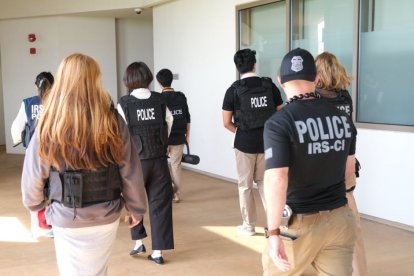IRS arms itself to the teeth: $10 million in combat gear since 2020
The latest update of the Militarization of the Federal Bureaucracy Report shows a major expansion of the administrative agencies' arsenal.

( IRS Citizen Academy / Flickr)
Why does the IRS need firearms? Adam Andrzejewski and his team asked themselves the same question before producing the Militarization of the Federal Bureaucracy Report for Open The Books, which demonstrates a marked trend in the Internal Revenue Service for increasingly arming its employees. Since 2006, the tax agency has invested $35.2 million (inflation applied) in firearms and military and tactical equipment.
Since then, the years that the Biden Administration has been in the White House have been the years of greatest spending on military equipment for the IRS. In 2021 alone, the agency spent $5 million on this line item. The agency currently has about 2,100 special agents, who are the employees that are allowed to be armed while carrying out their duties, in addition to being able to perform law enforcement duties.
Although spending on combat equipment is increasing, the number of agents using it is decreasing. In 1995, the IRS had 3,300 agents; a number that decreased over the years. Daniel Werfel, head of the IRS, announced this year that the number of armed employees would be expanded by 600 new positions, making for 3% of the agency's total staff expansion. With this personnel, the IRS would be among the 50 largest police departments in the country. IRS special agents have a long track record of conducting anti-crime work. They were the ones who captured Al Capone in the 1930s.
Nevertheless, it does not appear that the IRS will have to resort to using guns on a regular basis. According to Americans for Tax Reform, which cites a Treasury Department report between 2009 and 2011, IRS special agents only fired their guns 19 times. Nine of these discharges were intentional, while the other 11 were unintentional. In that period, IRS agents fired more times by mistake than willingly off a firing range.
The IRS's investment in combat equipment was primarily for small firearms, 9mm ammunition and bulletproof vests. The agency's weapon of choice is the .40 caliber Glock 22. The IRS arsenal also includes rifles, shotguns and AR-15-type automatic assault rifles for 5.56mm ammunition. They have 4,500 firearms and five million rounds of ammunition for their use, including 621 sliding and semi-automatic shotguns, 539 long-barrel rifles and 15 submachine guns.
The breakdown of expenses from 2020 onwards is as follows, according to the data provided in the report.
$1.2 million in ballistic shields, plus another $1.3 million in "other miscellaneous equipment for criminal investigation agents" - a very non-transparent description.
$474,000 in Smith & Wesson rifles
$467,000 in tactical service lighting
$463,000 in Beretta1301 tactical shotguns
$354,000 in tactical equipment backpacks
$267,000 in helmets
$243,000 in bulletproof vests
More federal agents than marines
The IRS is not the only agency that maintains a large staff of armed agents. The militarization situation in the IRS is similar to that of the Department of Veterans Affairs; the Department of Health and Human Services; the Social Security Agency; the Environmental Protection Agency; the Animal and Plant Inspection Service; and even NASA which have progressively invested in firearms and defense equipment for their workforces. Among all agencies not linked to the Department of Defense (military), Open The Books estimates that the number of armed federal agents with law enforcement authority is greater than that of all U.S. Marine Corps personnel, making up 200,000 vs. 180,000.
Among these agencies, the Department of Health and Human Services stands out. Since 2006, it has spent $154 million on the purchase of firearms and military equipment for its 500 special agents with the right to bear arms. With this data, Andrzejewski, author of the report, can't help but wonder why the federal government invests so much in militarizing its agencies, while the Biden Administration strives to increasingly restrict gun carrying and Second Amendment rights.
RECOMMENDATION





















